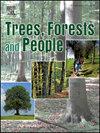Impact of resin tapping on the radial growth and climate sensitivity of naturally- regenerated Pinus roxburghii (Chir pine) in Western Nepal
IF 2.7
Q1 FORESTRY
引用次数: 0
Abstract
The study investigated the effect of resin tapping on radial growth and climate sensitivity of naturally regenerated Pinus roxburghii (chirpine) in Western Nepal. We collected core samples (dbh>30cm) from the community forest in the Salyan district: 26 from tapped and 33 from untapped trees situated in similar climatic, topographic, and ecological conditions. A tree-ring width chronology spanning 52 years was developed for both tapped and untapped trees. Statistical analyses, such as Pearson correlation and t-test, were used. Results indicate the untapped trees exhibited significantly higher basal area increment (BAI: p < 0.05) than those of tapped trees, indicating that resin tapping negatively impacts tree growth. Furthermore, both tapped and untapped trees exhibited a positive correlation between radial growth and temperatures in May, June, July and August suggesting critical role of temperature in influencing the growth of Pinus roxburghii trees whether they have been tapped for resin or not. The rainfall in January, February, March, April, August, October, and December positively influenced the radial growth of both tapped and untapped trees, with only the rainfall in January having a significant effect on growth. Radial growth is impacted by the resin tapping while decreasing its recovery strength after stress as well. This study highlights the need for alternative resin-tapping practices that minimize negative impacts on tree growth. It also emphasizes the importance of considering rainfall and temperature patterns when planning tapping activities to ensure sustained resin production and promote tree health.
树脂采伐对尼泊尔西部自然再生刺梨松径向生长和气候敏感性的影响
研究了树脂取穗对尼泊尔西部自然再生的红梨松径向生长和气候敏感性的影响。我们从Salyan地区的社区森林收集了核心样本(直径30厘米):26个来自采伐的树木,33个来自未开发的树木,这些树木位于相似的气候、地形和生态条件下。对采伐和未采伐的树木进行了52年的年轮宽度年表研究。采用Pearson相关、t检验等统计分析。结果表明,未开发树木的基底面积增量显著高于未开发树木(BAI: p <;0.05),说明树脂攻胶对树木生长有负面影响。在5月、6月、7月和8月,采伐和未采伐的红松径向生长与温度均呈显著正相关,表明无论采伐与否,温度都是影响红松生长的关键因素。1月、2月、3月、4月、8月、10月和12月的降雨量对采伐和未采伐树木的径向生长均有正向影响,只有1月的降雨量对生长有显著影响。树脂攻丝对径向生长有影响,同时降低了应力后的恢复强度。这项研究强调需要采用替代的树脂开采方法,以尽量减少对树木生长的负面影响。它还强调在规划采伐活动时考虑降雨和温度模式的重要性,以确保持续的树脂生产和促进树木健康。
本文章由计算机程序翻译,如有差异,请以英文原文为准。
求助全文
约1分钟内获得全文
求助全文
来源期刊

Trees, Forests and People
Economics, Econometrics and Finance-Economics, Econometrics and Finance (miscellaneous)
CiteScore
4.30
自引率
7.40%
发文量
172
审稿时长
56 days
 求助内容:
求助内容: 应助结果提醒方式:
应助结果提醒方式:


